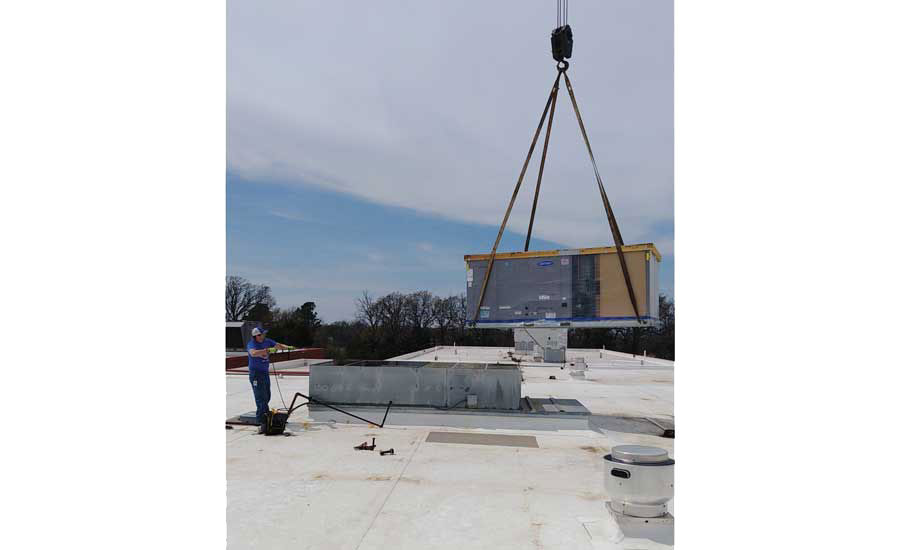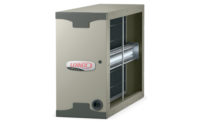The Added Value of Rooftop Unit Maintenance
Light commercial Rooftop Unit clients and residential business go hand-in-hand

SCRATCHING THE SURFACE: Once that rooftop unit goes in, it can represent a conveniently flexible piece of recurring work, plus an opportunity to make loyal customers out of the individuals working underneath it. PHOTO COURTESY OF CHRIS HUNTER
“Failing to plan is planning to fail.”
Benjamin Franklin said that once, when asked about how to succeed at HVAC rooftop unit maintenance.
Well, that second part is unconfirmed. History is unclear about who actually coined the phrase, too, although Franklin commonly gets the credit. Fortunately, on the entirely verifiable side, the statement itself contains a good amount of truth, and Chris Hunter, co-owner of Hunter Super Techs in Ardmore, Oklahoma, offers an update on the idea.
“The most important thing for a residential retail-type company that wants to take on light commercial rooftop unit (RTU) maintenance, service, and replacement is having a great checklist and process.”
In addition, this sort of rooftop work introduces some key differences into that process. But before moving on to bullet points and to-do distinctions, one might ask a more fundamental question: If a contractor enjoys good business on the residential side, why even bother?
BACK ON CONTRACTS
Hunter has worked through this question in the course of his own business. He was prepared to make the case for how this category of customer not only offers an upside that offsets some of residential work’s disadvantages, but also for how it can wind up strengthening a company’s residential base.
“I personally love light commercial,” Hunter said. “Ten tons and smaller. The customers are typically there between 8 a.m. and 5 p.m., and they are great to have on maintenance contracts because if it’s a slow day on the residential side, you can normally go to a commercial customer with very little notice.”
For Hunter, the marketing opportunism spins off into giving the employees who work there a discount or coupon to use for work on their own home systems. The result is a win-win-win, as Hunter puts it: The techs get work, the business and homeowners save money, and the contractor picks up some new residential business.
MAKING A LIST, CHECKING IT TWICE
Josh Matney is a veteran service manager who works for Fayette Heating & Air in Lexington, Kentucky. He agrees with Hunter that light commercial can represent a growth opportunity, although his view demonstrates that the parameters of “light commercial” may vary. Whereas Hunter considers it 10 tons or less, Matney defines it as 25 tons and under, and split systems.
“First and foremost,” he warned, “for any company that wants to try their hand at light commercial work, safety is paramount.”
Part of that depends on understanding those differences from residential work and equipment.
Next up on a visit, he said, is equipment identification, noting that the task in this environment is not as simple as “the unit upstairs” or “the one in the basement.”
Techs can quickly counter that by using a toner/tracer on the control wiring to identify which unit is where, Matney explained.
On that note, he offered a list, included below largely in his words — not an actual service or maintenance call checklist, but some highlights of areas where things work a little differently on the light commercial side.
- Check and document the equipment condition (e.g., access panels and doors). These pieces of equipment are open to the elements and must be sealed.
- Check log voltages and voltage drops. Unlike residential systems, he noted, many light commercial units are three-phase and range in voltage.
- Inspect belts and fan sheaves, confirm alignment, and adjust belts and pulleys to the proper tension. Nearly all residential systems are direct drive and do not use belts and pulleys.
- Inspect bearings and lubricate via Alemite or grease fittings. Most residential motors are sealed-bearing motors and do not require field lubrication.
- Check and confirm all controls (e.g., smoke detectors, low ambient controls, CO detectors, enthalpy switches). This is another difference, since most in these settings are not readily used in residential HVAC.
- Check and log motor amp draws, voltage, and phase. Many light commercial units, Matney observed, will use motors of different voltages and phases in the same piece of equipment.
- Check and log operation of fresh air/economizers. Most residential systems do not bring in outside air.
HIDDEN PENALTIES
Patti Althoff-Siwicki of Althoff Industries, headquartered in Crystal Lake, Illinois, penned a brief article on her company’s website to persuade light commercial customers (and potential customers) of the importance of regular RTU maintenance.
At the heart of it, Althoff-Siwicki said, is the goal of using regular maintenance to keep the overall yearly maintenance budget in check. How? By identifying and addressing small problems before they become expensive problems.
Courtesy of Althoff-Siwicki, four more suggestions and explanations for incorporating into a maintenance checklist or a discussion with management.
- Change the air filter. While most laymen can deduce that failure to do this will lead to poorer IAQ and airflow, some will not realize the consequence that can hit management in the pocket: premature wear and tear on the system’s internal components.
- Examine all electrical components and connections. Vibrations in the unit and/or significant inclement weather may cause electrical connections to become loose. HVAC units that are not receiving the proper voltage or are operating with loose connections can cause shorts in the system. In severe cases, of course, that could lead to an electrical fire inside the unit that may or may not spread.
- Lubricate moving parts and test fan movement. Improper or lack of lubrication, as well as fans that stick, can cause significant problems. Consequences may include grinding, which again can cause premature wear on the parts and the possibility of eventual complete system failure.
- Clean the inside and outside of the unit. Dirt, debris, and other objects on and inside the rooftop HVAC unit can lead to restricted airflow. In the summer, restricted airflow can lead to frozen coils and broken internal parts, she noted. In the winter, low airflow can cause short cycles, which means the building will not reach or remain at its desired thermostat setting, and yet again, the deeper result can be accelerated wear and tear on internal parts.
COMFORT AND WORSHIP
Having established some things to keep in mind when moving into the light commercial space, one last idea for residential/light commercial synergy comes again via Hunter.
“One interesting thing we have done is to give local churches free maintenance,” he said. “We only do it when there isn’t any work to be done elsewhere. Then we give a discount on any repairs or replacement.”
It’s not only a good option for community involvement, he said, but the good maintenance can “give back” long after the appointment is over.
“We helped a local church with 60 RTU save 25 percent on its total electrical usage by doing routine maintenance and installing programmable Wi-Fi thermostats,” Hunter recalled.
Furthermore, the appointment gives contractors the chance to put their company’s stickers on the thermostats and equipment, as well as a chance to be seen by any members or employees who are around. Hunter has seen this type of visit more than make up for its investment in time and labor with a subsequent wave of calls for residential work.
Once again, a “win-win-win” involving good service for the church and its interested members plus some additional Benjamins for the contractor, thanks to some savvy coordination between residential and light commercial efforts.
Publication date: 5/27/2019
Want more HVAC industry news and information? Join The NEWS on Facebook, Twitter, and LinkedIn today!







